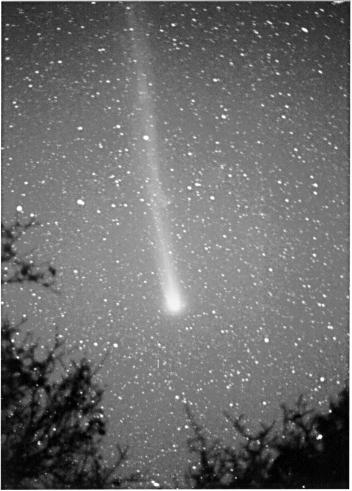Parable of the Comet
I have a confession - I am an astronomy geek. That may not be much of a surprise to those of you who have seen my 8 inch telescope or watched my excitement looking to the skies from a dark, country location away from the bright lights of the city. Astronomy captured my imagination early in my life and has captivated me ever since.
For the love of comets…
Most of my astronomical affection is focused on the lonely comet. Astronomers theorize that many of these small bodies of dust and ice orbit our sun at a very great distance in a large spherical Oort cloud. Small tugs of gravity from planets or other stars may cause one of the cold, dark comets to plunge towards the sun into the inner solar system where it may put on a spectacular show. Comet tails of gas, dust, ice are blown away from the comet by the solar wind and illuminated by reflected sunlight. Given a favorable combination of proximity to Earth and angle of illumination by the Sun, a comet’s tail may appear to stretch across a considerable portion of the sky.
Of course the most famous of all comets is Halley’s Comet. The orbit of Halley’s comet causes it to visit the inner solar system about once every 75 years, and for the 1986 visit I was eager to catch a glimpse of my first comet. In spite of cautions from astronomers that this particular appearance of the noteworthy visitor would be disappointing due to the Earth’s position relative to its approach, my family and I set off one cold spring morning to view the comet before sunrise. With star maps in hand we were barely able to find the fuzzball near the southern horizon. Spectacular comets would have to wait for another day.
For me, that day came ten years after the dismal performance of Halley. In March 1996, Comet Hyakutake passed very close to the Earth, and because of its close proximity and long gas tail, this comet was simply incredible to behold from the pitch black sky I found near Stillwater, Oklahoma. I was amazed by the huge tail that seemed to span about half of the sky like a giant search light. Armed with a 35 mm camera, tripod, and fast film, I captured some of my first photographs of a comet.

Just a year later, another incredible comet graced the Oklahoma skies. Comet Hale-Bopp, predicted to be bright and beautiful, did not disappoint those who saw it over several months of naked-eye visibility. I captured a photograph if it hanging above the silos at my wife’s family farm near Cushing.

On November 4, 2010 the NASA EPOXI spacecraft will fly by Comet Hartley 2, and of course I will be following the encounter on the NASA website!
Parable of the Comet
I wonder what it must have been like for our ancestors to see comets hanging in the sky. For those without electric lights to artificially brighten the sky at night, comets would have been more visible, impressive, and perhaps even ominous. History records that ancient peoples often feared comets as foreboding signs of horrible events to come.
Although the Bible does not record any stories that Jesus told about comets, I imagine that he would have pointed to comets not as signs of evil but rather demonstrations of God’s love for us and reminders of our relationship with the Son. For you see, we are all like comets created from dust left over from an ancient supernova. When we are far from the Son, our hearts are frozen and we are alone in darkness. Yet even in our darkest moments, the Son draws us to Him. As we humbly approach the Son, our hearts melt and we lose ourselves in the warmth of His love. The Holy Spirit is a wind from the Son that strips away our hurts, loneliness, and selfishness and reveals the Son. The nearer we get to the Son, the more we reflect His light to others who are watching in the darkness.
I love comets because they draw me to the Son. When I look up at the amazing universe that God has created, I want to live my life reflecting the Son’s light - not to draw attention to myself, but to lead those in the darkness to Him. After all, God loved each of us so much that He gave us the Son, and whoever approaches the Son will not be filled with coldness, darkness, and death but with warmth, light, and life.
